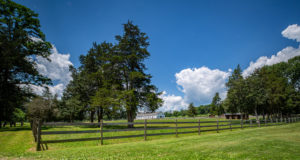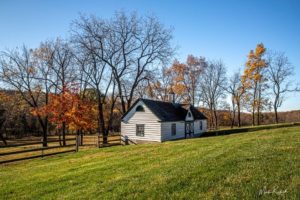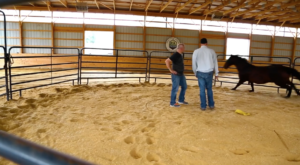
Brad Langenberg
Horses have a way of touching our hearts in the darkest of times. The bond that can be created with a horse is true and authentic. Who isn’t touched by a nicker from their favorite horse? Or when the horse follows you freely? Many horse lovers use time in the barn as a therapeutic way of coping with whatever life throws their way.
People have been using the powerful bond with equines as therapy for addiction. They are forgiving, honest animals that bring so much joy to people. Whether it’s their incredible athletic ability, their personality, and/or that ability to connect with people, they touch us in ways that are hard to define and their impact can be life changing.
Brad Langenberg has been involved with cow horses over the years and now shows cutting horses.
Langenberg, who grew up on a Nebraska cattle ranch, had always been involved with horses. He travelled to the Santa Ynez Valley in California to enroll in a recovery program himself and, as a former addict, has spent 30 years assisting others in overcoming addiction.
Langenberg pursued horsemanship because he heard about an equine therapy program. He had an idea to put the two together noting the similarities in working with horses and people.
Two years ago he accepted a position in New Jersey at Harmony Hollow Run and joined the FARM Team (Facilitating Active Recovery Mission). The owner of the farm, Joe Jingoli Jr., who had heard Langenberg speak, and watched him practice equine therapy, asked him to come and look at one of their horses. They hit it off and Jingoli asked Langenberg to run their recovery program at the Farm.

Harmony Hollow Run, home of the FARM team.
The FARM team offers a transition program where the participants travel to the farm each day and go home to a sober living house or a treatment facility in the evening. There are just six people in the program at a time, Langenberg said. The participants work at the farm and get paid. Everything they do there is based on the Alcoholics Anonymous 12 Steps program.
“[With the FARM team] they get all the support they need and they get paid to be here…It takes about a year to unthaw And it takes three to four years to really get your thinking clearer and get centered and grounded.”
Langenberg brings an equine aspect into the recovery program. They use any horse that is safe. They have some that are tougher to connect with which can be a great challenge for participants. They even have a daughter of High Brow Cat!
“If it has four legs and a tail, it will work!”
“I’m [helping] people that have never really connected with anything. I love putting them in the round pen because the way they go about a relationship with that horse tells me how they handle relationships with other people. It’s so clear cut. Just the way they walk, how they approach the horse, the way they walk into the pen, everything starts to tell me a story about how they handle situations,” Langenberg explained.
“That horse could really care less what your income is, what you look like, your gender. What I noticed was that horses knew who was separate and who could connect. I bring that into my program because that is what the universe is like too. The universe doesn’t care how much money you made.”

“Harmony Hollow’s mission is to provide individuals in recovery an environment to focus on their spirituality and emotional sobriety through nature and equine experiences.”
“A lot of recovery is about learning how to connect. I always heard it was about the fear of the unknown. It’s not, it’s fear of letting go of the known. On this path to recovery, I get a chance to show these [participants] the way they’ve been handling situations and I also give them a chance to feel what it feels like to be connected,” Langenberg said.
He said that being around horses and really great horsemen, he had to learn how to reward the slightest try. And make what he wanted easy and the wrong thing difficult. Langenberg said those concepts really work with people in recovery too.
“The main thing is, I give people different exercises to do with the horse…they work in groups a lot. That’s everyone’s most difficult challenge – relationships. And it gives me an opportunity to see that. All horse communication is non-verbal…anywhere from 50-90% of relationships is non-verbal.”
“The way you do anything, shows how you handle everything,” he added.
A young man came into the program who had seen his brother commit murder. His brother was on death row. Langenberg said that that kid was tough, so he put him in the round pen. It took a long time, but eventually, the horse broke through his defense mechanisms. The young man suddenly stopped resisting and broke down after connecting with the horse. Langenberg said most of the places he has worked at bring him the toughest people because the horses help break walls down in ways people can’t.
Langenberg also works with young ladies with eating disorders.
“I’m trying to pull them out of that [mindset] because there’s a lot of shame because they’re locked in. If I can get them to let go of that shame by starting to connect into the now…”
“The big problem with alcoholic disease is there’s anxiety which is in the future or there’s in the past which is depression. We all have it to some extent. We’re very seldom in this day.”
One of the exercises Langenberg does is set up an obstacle course and have the participants lead the horse through the obstacles without a halter, lead rope or bridle.

“There is nothing like standing in front of a 1200 lb animal to get you grounded in the present…”
“If I give them enough time, one of them figures out how to connect with the horse and the horse starts to move with them and they take their time with it, they get that horse walking with them through the obstacles…They have to match their energy with that horse. They can’t come in too ‘hot’, they have to regulate themselves.”
He said the horse can go from emergency flight mode to eating grass like nothing happened. People have to be able to regulate themselves like that. It’s about setting the tone, he added. He compares his work to horse training. Just set up the situation and wait. Horses are forgiving. They don’t hold grudges. Everyday is a new day.
“That horse is always changing and it’s always going forward but it’s always right now. That horse isn’t stuck in yesterday, he’s right now.”
Alcoholism and addiction are diseases of the mind Langenberg said. It’s not the way people drink or use drugs, it’s the way they think that needs to be treated. It’s about becoming more aware and becoming grounded in the present.
“There is nothing like standing in front of a 1200 lb animal to get you grounded in the present. When they reach out and touch the horse for the first time, you can see them start to get grounded in the moment and get connected.”
“This whole journey [to recovery] isn’t about attaining something, it’s about letting go of something.”
“Right thinking is thinking about the right thing at the right time.”
What you should be thinking about is what you’re doing right now. That is the whole premise of the program Langenberg said.
